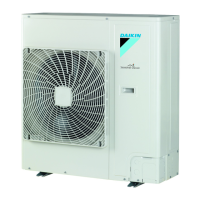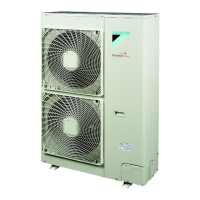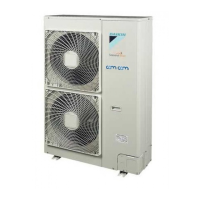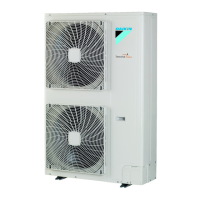
Do you have a question about the Daikin RZQG100L8V1B and is the answer not in the manual?
| Cooling Capacity | 9.5 kW |
|---|---|
| Heating Capacity | 10.8 kW |
| Refrigerant | R-410A |
| Power Supply | 3 Phase, 380-415V, 50Hz |
| Type | Split System Air Conditioner |
Explains the meaning of warning symbols used in the manual for safety.
Defines key terms used throughout the installation manual for clarity.
Warns about dangers of electrical shock during installation and servicing.
Warns against touching hot or cold piping and internal unit parts.
Defines the scope of this manual, covering handling and installation of specific unit models.
Covers essential precautions before commencing installation work.
Details strict cautions for handling R410A refrigerant to ensure system integrity.
Details procedures for installing the outdoor unit, including model identification.
Lists and illustrates the accessories included with the outdoor unit.
Provides instructions on how to safely handle and lift the outdoor unit.
Outlines general conditions and requirements for selecting an appropriate installation site.
Provides specific guidelines for selecting installation sites in low ambient temperature conditions.
Details requirements for foundation strength and levelness for secure unit installation.
Describes methods to secure the unit and prevent it from falling over.
Guides on proper drain pipe installation and disposal to prevent issues.
Specifies the required clearance around the unit for proper installation and servicing.
Specifies the required material and temper grade for refrigerant piping.
Lists the correct pipe sizes for gas and liquid refrigerant lines based on model.
Guides on selecting appropriate branch pipe sizes for different system configurations.
Details maximum allowable piping lengths and height differences between units.
Provides instructions and torque specifications for creating proper flare connections.
Offers guidance on brazing techniques and precautions for refrigerant piping.
Explains how to safely operate the stop valves for refrigerant flow control.
Lists tightening torques for various components like stem caps and service ports.
Details methods to prevent dirt, dust, or small animals from entering the piping.
Advises on proper insulation and connection of field piping to prevent issues.
Explains when and where to install traps in riser gas piping for oil return.
Covers general procedures for leak testing and vacuum drying the refrigerant system.
Lists the necessary equipment and setup for leak testing and vacuum drying.
Details methods for performing vacuum and pressure leak tests on the system.
Explains the procedure for removing moisture from the refrigerant system.
Provides crucial details about the refrigerant type, GWP, and labeling requirements.
Outlines safety precautions and general guidelines for charging refrigerant.
Guides on calculating the correct amount of refrigerant to add based on piping length.
Explains the process for complete refrigerant recharging after leaks or servicing.
Provides tables for determining total refrigerant charge based on piping length.
Highlights essential safety precautions for electrical wiring.
Details how to connect power supply and wiring between indoor and outdoor units.
Provides additional precautions for power supply and inter-unit wiring connections.
Lists specifications for standard wiring components like circuit breakers and wire types.
Lists checks to perform before starting the unit's test operation.
Explains how to confirm remote controller settings for various series.
Details the procedure for conducting the initial test run of the installed unit.
Offers precautions to ensure safe and effective test runs.
Provides guidance for diagnosing common issues encountered during initial installation.











